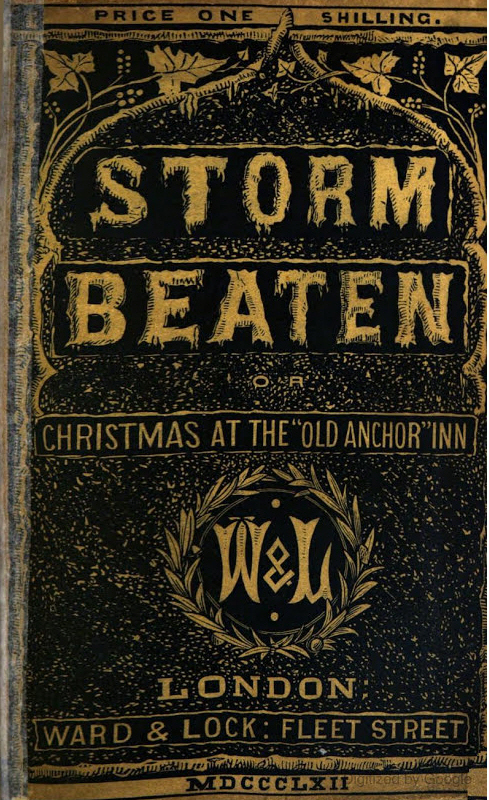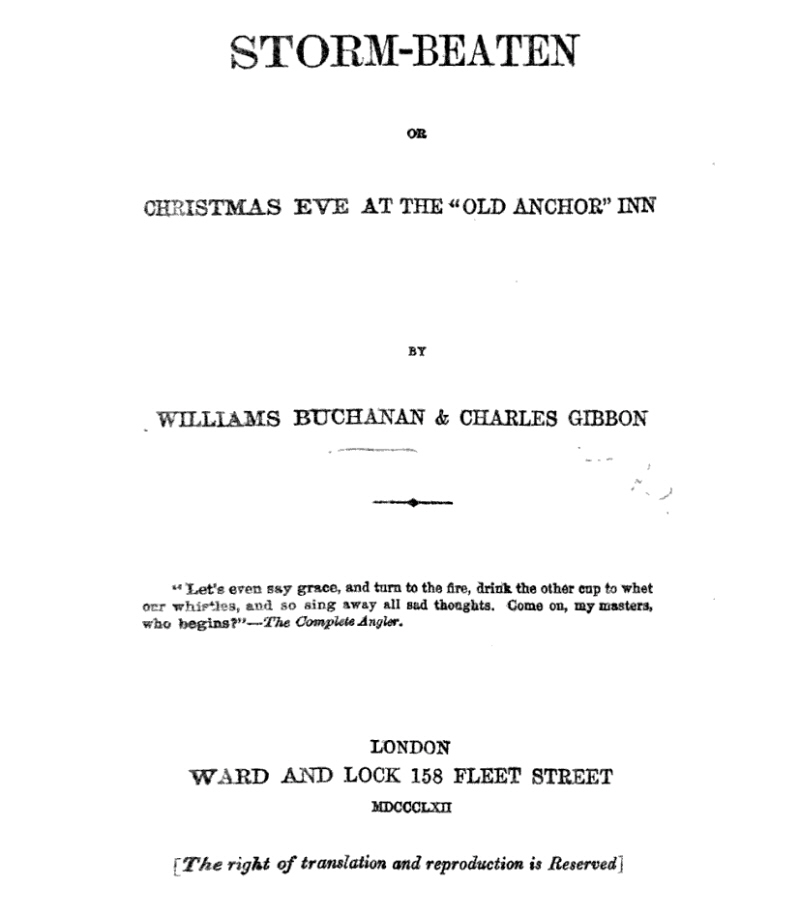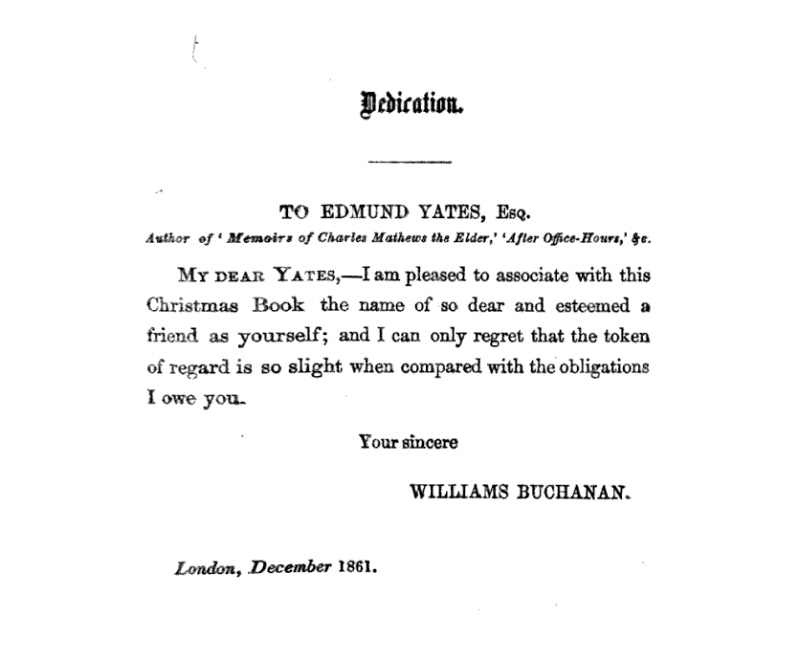ROBERT WILLIAMS BUCHANAN (1841 - 1901)
|
ROBERT WILLIAMS BUCHANAN (1841 - 1901) |
|
|
|
|
|
|
|
|
FICTION
1. The Novels ii. The Moment After iii. The Wedding Ring iv. List of Novels
i. Stormbeaten iii. Other Stories
It is safe to say that Robert Buchanan’s novels have not stood the test of time. There are 27 titles listed in the Bibliography, which, of itself, implies that Buchanan’s novels must have enjoyed some measure of popularity in their day but none of them have managed to seep into the public consciousness to become ‘classics’ and they have no standing in the more rarefied atmosphere of the academic world. Only a handful were still in print in the early years of the twentieth century and only three were adapted for the cinema, God and the Man, Matt and Woman and the Man, all in the silent era (and only the latter, an Italian production, has survived). The quality of Buchanan’s novels varies widely. He began writing novels when he was living in Ireland, after his career as a poet had been destroyed by the ‘Fleshly School’ controversy and before he started to achieve success as a dramatist. Chapter 18 of Harriett Jay’s biography, ‘First Ideas of Novel Writing’, gives a fascinating portrait of Buchanan at work. His initial idea was to write a novel in collaboration with William Canton and the chapter contains his correspondence on the matter. The collaboration failed however and Buchanan continued alone, producing his first novel, The Shadow of the Sword, which was initially published in The Gentleman’s Magazine in monthly instalments. In Chapter 20 Harriett Jay offers more insights into Buchanan’s working methods including the following passage: “The arrangements made, Mr. Buchanan set to work with a will and wrote his monthly instalments with keen pleasure. He had the story very clearly mapped out from start to finish, so that when it came to be written it flowed easily from his pen. His monthly parts were the neatest things I have ever seen written, as they were in a very tiny but perfectly clear hand on ordinary sheets of note-paper, and almost without an erasure. I fear, however, he was never far ahead with his “copy,” the writing of which he invariably postponed till the last possible moment, and this method of his was the cause later on of some trouble. While the story was running in the magazine there occurred a fire on the premises of Messrs. Grant, the publishers, and a good deal of valuable manuscript was destroyed, amongst it the last instalment of the “Shadow of the Sword.” As usual this had arrived late, too late for the editor to have had an opportunity of sending a proof and as Mr. Buchanan himself had kept no copy (there was no typewriting in those days), the only thing to be done was for him to set to work and rewrite the instalment. This he did with such marvellous rapidity that the appearance of the magazine was not delayed by a single day.” The Shadow of the Sword was published in book form in 1876, but despite its success, Buchanan waited another five years before publishing A Child of Nature and then, God and the Man. After this, there came a steady stream of titles. At the close of Chapter 20, Harriett Jay gives her own assessment of Buchanan’s novels: “Into these two novels, “The Shadow of the Sword” and “God and the Man,” Mr. Buchanan, as I have shown, put the very best work of which he was capable. Both were conceived and partly written as poems, and both remained poems although they were given to the world in prose form. Had things gone well with him he would, in all probability, have continued to give the world of his very best, but after the publication of “God and the Man” he had to face a calamity which would have broken down many a stronger man. His young wife, who had never been strong, was stricken with the cruellest of all diseases, cancer, and for two long years she was slowly dying. He was too poor a man to be able to sit down and nurse his grief, work had to be done, and he did it, though not with the same heart, the same enthusiasm. His great ambition now was to make money, and so he scribbled at fiction in order to attain this end. His output was very great and very rapid, and although his income increased, his position as a novelist declined, many of his later novels were written, as it were, with his left hand, and it is certain that had he been a man of means they would never have been written at all.” In The Longman Companion to Victorian Fiction, John Sutherland offers the following assessment of Buchanan’s novels: “His first novel, The Shadow Of The Sword (1876), has as its hero a Breton conscientious objector in the Napoleonic Wars. It has a powerful final chapter, describing the tormented sleeping hours of the exiled emperor. His finest work is usually judged to be God And The Man (1881), a study in the futile psychology of hatred with a terrific action climax in the polar wastelands. The Martyrdom Of Madeline (1882) follows the fortunes of a resourceful heroine after she is betrayed in love by her French music master. Foxglove Manor (1884) has a ritualist clergyman who seduces and abandons a young girl, and goes on to various acts of Romish apostasy. The Master Of The Mine (1885) has a Cornish mining setting. The Heir Of Linne (1888) is a conventional inheritance melodrama with an 1840s Scottish setting. Effie Hetherington (1896) is a story of ill-assorted marriage and justified desertion with some similarity to Hardy’s Jude The Obscure.” John Cassidy in his book about Buchanan, published in 1973, singled out five of the novels as “too good to be forgotten”: The Shadow of the Sword, The Martyrdom of Madeline, Effie Hetherington, Diana’s Hunting, and Father Anthony. Christopher D. Murray’s Robert Buchanan (1841-1901) : An assessment of his career (Queen Mary, University of London, 1974. 282 p. - available from the British Library’s EThOS), has a chapter on Buchanan’s novels, and also an appendix concerning his dealings with Chatto & Windus, which raises some questions about the authorship of Rachel Dene and Lady Kilpatrick. Some of Buchanan’s correspondence with Chatto & Windus (including the Lady Kilpatrick letters) is available on this site. ___
In 2012, when I was checking online newspaper archives for Buchanan, I came across a serialisation in The York Herald of an otherwise unpublished novel - A Hero In Spite Of Himself. This was a novelisation of the play which Buchanan took to New York in 1884 and which was rejected by Messrs. Shook & Collier of the Union Square Theatre. The play was never produced and the novel was never published in book form so I was under no illusions when I started reading it. Its stage origins are only too obvious, but, for someone brought up on old cowboy pictures I found it quite enjoyable. It is available on this site via the link below: (A novel by Robert Buchanan, serialised in The York Herald, 2 October - 24 December, 1886). ___
I have also added another serialisation of a Buchanan novel from The York Herald to the site: The Moment After. The novel was published by William Heinemann in 1890, but this earlier version appeared in four episodes in The York Herald on consecutive Saturdays from 1st January to 22nd January, 1887. It also appeared in other newspapers and periodicals, including The People (2 January, 1887), The Nottinghamshire Guardian (19 October, 1895) and The Bluejacket and Coastguard Gazette (1901), when the title was changed to The Borders of Another World. (A novel by Robert Buchanan, serialised in The York Herald, 1 - 22 January, 1887). This version of The Moment After is also available for download as a zipped .rtf file. The serial version is only 14,000 words long, so is more of a novella, and Buchanan expanded this for the book version, which is available to download here. ___
One of the more obscure Buchanan novels is The Wedding Ring, which was published in America by the Cassell Publishing Co. in 1891. It was also serialised in The Bristol Mercury and Daily Post (and presumably other provincial newspapers) from January 10th to March 28th, 1891. Two years later, Chatto & Windus published The Wedding Ring under the title Woman and the Man. There is some correspondence between Buchanan and Chatto on the matter, although it is not clear whether Buchanan was concealing the previous publication of the novel. Although The Wedding Ring is not available at the Internet Archive, Woman and the Man is, and can be compared to the opening chapters of the serial version of The Wedding Ring below |
|
|
|
The remaining chapters of The Wedding Ring from The Bristol Mercury serialisation are also available: Chapters 3 - 4 (17/1/1891) Chapters 5 - 6 (24/1/1891) Chapters 7 - 8 (31/1/1891) Chapters 9 - 10 (7/2/1891) Chapters 11 - 12 (14/2/1891) Chapters 13 - 14 (21/2/1891) Chapters 15 - 16 (28/2/1891) Chapters 17 - 18 (7/3/1891) Chapters 19 - 20 (14/3/1891) Chapters 21 - 22 (21/3/1891) Chapters 23 - 24 (28/3/1891) On a cursory examination of this serial version of The Wedding Ring and Woman and the Man, the main difference seems to be the addition of an extra chapter in the later novel. In Woman and the Man, ‘Chapter 23: Flight’, is followed by ‘Chapter 24: Mr. Stokes Earns His Money’, before ending with ‘Chapter 25: ‘A Last Reckoning’. In The Wedding Ring ‘Chapter 23: Flight’ is followed by ‘Chapter 24: The Last Meeting’. |
 |
|||||
|
Author of “Squire Kate” ROBERT BUCHANAN Lovell, Coryell & Co.
The Shadow of the Sword. 3 vols. London: Richard Bentley and Son, 1876. A Child of Nature. 3 vols. London: Richard Bentley and Son, 1881. God and the Man. London: Chatto & Windus, 1881. The Martyrdom of Madeline. 3 vols. London: Chatto & Windus, 1882. Love Me For Ever. London: Chatto & Windus, 1883. Annan Water. 3 vols. London: Chatto & Windus, 1883. The New Abelard. 3 vols. London: Chatto & Windus, 1884. Foxglove Manor. 3 vols. London: Chatto & Windus, 1884. Matt: A Story of a Caravan. London: Chatto & Windus, 1885. (U.S. title: Matt: A Tale of a Caravan) Stormy Waters. 3 vols. London: John and Robert Maxwell, 1885. (A novelization of the 1883 play, A Sailor and His Lass, written in collaboration with Augustus Harris.) [reviews] The Master of the Mine. 2 vols. London: Richard Bentley and Son, 1885. A Hero In Spite Of Himself. (A novelization of the 1884 play.) Serialised in The York Herald, October 2nd to December 24th, 1886, otherwise unpublished. [Available on this site.] That Winter Night: or, Love’s Victory. Bristol: Arrowsmith’s Bristol Library, 1886. The Heir of Linne. 2 vols. London: Chatto & Windus, 1888. The Moment After: a tale of the unseen. London: William Heinemann, 1890. The Wedding Ring: a tale of to-day. New York: Cassell Publishing Co., 1891. Come Live with Me and Be My Love: an English pastoral. London: William Heinemann, 1892. (Alternate U.S. title: Squire Kate.) [Available at the Internet Archive [reviews] Rachel Dene: a tale of the Deepdale Mills. 2 vols. London: Chatto & Windus, 1894. The Charlatan. (In collaboration with Henry Murray.) London: Chatto & Windus, 1895. Diana’s Hunting. London: T. Fisher Unwin, 1895. Lady Kilpatrick. London: Chatto & Windus, 1895. A Marriage by Capture. London: T. Fisher Unwin, 1896. Effie Hetherington. London: T. Fisher Unwin, 1896. The Rev. Annabel Lee: a tale of to-morrow. London: C. Arthur Pearson, Ltd. 1898. Father Anthony. London: John Long, 1898. Andromeda: an idyll of the Great River. London: Chatto & Windus, 1900. The Peep O’ day boy: a Romance of ’98. London: John Dicks, 1902. _____
Buchanan published two collections of short stories during his career, one towards the start and one near the end: Stormbeaten: or Christmas Eve at the “Old Anchor” Inn. |
|||||
 |
|||||
 |
 |
|
This book only became available online recently (c. 2017) and for a number of years the only information I had about its contents was kindly provided by Dr. Richard Beaton. It is a “Christmas book” in the Dickens tradition (i.e. a collection of stories and poems with a linking narrative), and it has a dedication to Edmund Yates, dated December 1861, signed “Williams Buchanan” with a note before the text stating that parts of the book had been published in All the Year Round and Once a Week. There is no further indication as to who wrote what, but one presumes that all the poems (which are available here) are by Buchanan and there is one story, ‘Jessie Cameron’s Bairn’ which has been identified as Buchanan’s. The contents are as follows: Introduction: How the good ship Boomerang was Storm-Beaten; how we were compelled to put back into the port of Scuttleton-upon-Kegg; and how we came together on Christmas-eve in the “Old Anchor Inn”. The book is not mentioned in Harriett Jay’s biography, but Buchanan’s friendship with Gibbon (with whom he also wrote The Rathboys) is dealt with in Chapter VIII: Friendships, 1864. Here’s the opening section: “Then it was that he made the acquaintance of Charles Gibbon, who was a year or so younger than himself. The pair first met at Herne Bay, whither they had gone for a few days’ recreation, and on their return to London they set up housekeeping together, Gibbon going to share the “bankrupt garret” in Stamford Street. Besides assisting his friend in the production of copy for Mr. Maxwell, Mr. Gibbon wrote a good deal of fiction on his own account. Although their earnings at that time were not great they were both at work far into the watches of the night, reading, writing, studying, like young fellows cramming for an examination. Every night a pot of strong coffee was set upon the hob, and out of this pot they refreshed themselves, fighting hard against the natural desire for sleep, and again and again tumbling off into a troubled doze till daylight came and they crept wearily to bed. There was no absolute necessity for their burning the midnight oil in this fashion, and indeed the poet never contracted this ugly habit until Mr. Gibbon became his companion.” A second edition of the book was published in December, 1869. The review in The Spectator prompted a response from Buchanan: The Spectator (25 December, 1869) Stormbeaten. By Robert Buchanan and Charles Gibbon. (Ward, Lock, and Tyler.)—This little book contains some very good and effective, and some very poor and melodramatic Christmas stories, and two or three spirited pieces of verse,—we conclude, by Mr. Buchanan,—which, though they will not for a moment compare with his true poems, are very far indeed above the ordinary verse of Christmas annuals. “Reuben Gray, or the sickly gentleman’s story,” is one of the best of these pieces of verse; and the “Gold-digger’s Story” also contains some very spirited descriptive verse. Still, neither of them is at all of the class of poems by which Mr. Buchanan has gained, and we trust will keep, his high character as a poet. The comic prose stories are, we think, the worst. “A Parisian Mystery” is one of the best. ___
The Spectator (1 January, 1870) MR. BUCHANAN AND HIS PUBLISHERS. [TO THE EDITOR OF THE “SPECTATOR.”] SIR,—I observe in last Saturday’s Spectator a review of a work entitled “Stormbeaten,” published by Messrs. Ward and Lock, and purporting to be a new work by “Messrs. Robert Buchanan and Charles Gibbon.” As the publication of the work at the present moment involves a double deception, permit me to offer some words of explanation. ROBERT BUCHANAN. ___
Reviews of Stormbeaten: or Christmas Eve at the Old Anchor Inn _____
Red and White Heather: North Country tales and ballads. Contents: A Highland Princess Available at the Internet Archive. The longest story in the collection is ‘Miss Jean’s Love Story’ which is actually one of Buchanan’s earliest stories, ‘A Heart Struggle’ (available below). ___
Reviews of Red and White Heather: North Country tales and ballads _____
Throughout his career Buchanan also wrote stories for magazines and newspapers, but these were never collected and published in book form. John A. Cassidy’s bibliography only lists two as being significant, A Heart Struggle and Lady Letitia’s Lilliput Hand. These are available on this site along with some others I have come across. One of the earliest, My Aunt’s Christmas, is set in the village of Caverford, an obvious (and rather rare) nod to Buchanan’s birthplace, and two later ones, My Good Fairy and Berinthia, recall Buchanan’s early days in London. Jessie Cameron’s Bairn My Aunt’s Christmas A Heart Struggle. A Tale in Two Parts Lady Letitia’s Lilliput Hand A Roman Supper Poor Bonnithorne! The Heir Miss Birchington’s Love Story My Good Fairy A Dream; and a Deduction A Queer Theatrical Engagement The Peacocks’ Feathers Berinthia An Old Reckoning
|
|
|
|
|
|
|